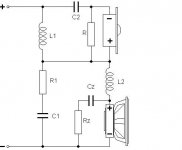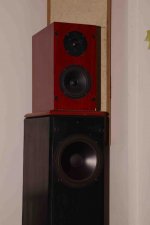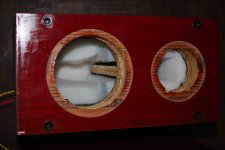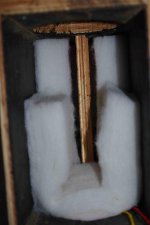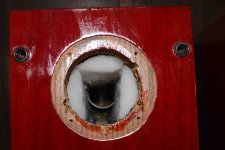I've done it
OK thread started, kick in every body and give your thoughts, give my ideas a good kicking.
http://www.diyaudio.com/forums/multi-way/153415-diy-audio-3-way-reference-project.html#post1951172
What would be the reference point?
There are a number of good designs around for 3-ways but following on from the premise of the original 2-way build it would have to use readily available drivers, have a reasonable upfront cost ( which probably rules out SEAS and Scan-Speak drivers ) have a relatively simple XO and be reasonable easy to build the cabinet.
New thread is now needed too.
regards
Moondog
OK thread started, kick in every body and give your thoughts, give my ideas a good kicking.
http://www.diyaudio.com/forums/multi-way/153415-diy-audio-3-way-reference-project.html#post1951172
Ok, just adding my $0.02 to the end of the thread, i have just got around to it, and i really think this thread needs some new reports from people who have built it.
I am playing around at the moment because we need new bedroom speakers and i have these drivers still in the cardboard.
OK I am a little slow to get moving, we could live with these just with the single cap in series with the tweeter, but later today I'm going to get some coils and play with rabbitz series XO, although i have to say i don't think CC and I will need much tweeter padding at all.
Worth re-opening the thread as there seems to be plenty of both the tweeter and the P-13 around still,
I am playing around at the moment because we need new bedroom speakers and i have these drivers still in the cardboard.
OK I am a little slow to get moving, we could live with these just with the single cap in series with the tweeter, but later today I'm going to get some coils and play with rabbitz series XO, although i have to say i don't think CC and I will need much tweeter padding at all.
Worth re-opening the thread as there seems to be plenty of both the tweeter and the P-13 around still,
Query for those who built this, did any-one experiment with a second order series on the tweeter??
I have been playing with the first order series XO and it is fine and sweet until i crank up the volume, tweeter seems ti distort a little at high but reasonable levels, and I was thinking that it may need a little less bass coming through.
other option is to buy some more parts and use the AR series XO, which i have not tried yet
I have been playing with the first order series XO and it is fine and sweet until i crank up the volume, tweeter seems ti distort a little at high but reasonable levels, and I was thinking that it may need a little less bass coming through.
other option is to buy some more parts and use the AR series XO, which i have not tried yet
Hi,
I'm building this with 'Rabbitz' series x/o, detailed here.
The project started off as a TLb with dual P13's & single cap. It sounded very nice for vocals and some type of music but does not cut it for Jazz-Rock & Rock, even with a sub.
That design developed into a 2-way with one P13 removed. The TLb towers remained and the x/o went active. It sounded fantastic, with great dynamics. Imaging suffered and the sound was too 'clean'. If the recording was so-so the speaker made no qualms about it.
The cabinet was then dissected and will get 'rabbitz' x/o.
I will post listening impressions with pics when done.
Cheers.
I'm building this with 'Rabbitz' series x/o, detailed here.
The project started off as a TLb with dual P13's & single cap. It sounded very nice for vocals and some type of music but does not cut it for Jazz-Rock & Rock, even with a sub.
That design developed into a 2-way with one P13 removed. The TLb towers remained and the x/o went active. It sounded fantastic, with great dynamics. Imaging suffered and the sound was too 'clean'. If the recording was so-so the speaker made no qualms about it.
The cabinet was then dissected and will get 'rabbitz' x/o.
I will post listening impressions with pics when done.
Cheers.
Last edited:
Query for those who built this, did any-one experiment with a second order series on the tweeter??
I have been playing with the first order series XO and it is fine and sweet until i crank up the volume, tweeter seems ti distort a little at high but reasonable levels, and I was thinking that it may need a little less bass coming through.
other option is to buy some more parts and use the AR series XO, which i have not tried yet
The AR series rolls off the tweeter and woofer much steeper than the standard series. I can't remember the exact slope but around 2nd to 3rd order acoustic.
Hi, what about the filling material to be used here. I have the walls lined with bitumen sheets like I always do. The cabinet is nice and solid.
I was planning to go with 2" polyfil on:
a) entire rear panel
b) top
c) bottom
The port has a 2" clearance from the inner top of the cabinet and that space should comfortably take the filling material. The material will be fixed to the walls with velcro which I've tested and works just fine.
What do you guys think ?
Cheers
I was planning to go with 2" polyfil on:
a) entire rear panel
b) top
c) bottom
The port has a 2" clearance from the inner top of the cabinet and that space should comfortably take the filling material. The material will be fixed to the walls with velcro which I've tested and works just fine.
What do you guys think ?
Cheers
Have a look at this post and sketch (also posts #115 & #116).
http://www.diyaudio.com/forums/multi-way/143326-kit-australia-6.html#post1837618
The damping is in a "L" shape so the damping sits in the box away from the wall behind the woofer. It also allows a clear path from the woofer to the vent tube. You could use a "Z" shape if you desire to line the top also but it's not necessary plus it could fall over the vent inlet and block it.
http://www.diyaudio.com/forums/multi-way/143326-kit-australia-6.html#post1837618
The damping is in a "L" shape so the damping sits in the box away from the wall behind the woofer. It also allows a clear path from the woofer to the vent tube. You could use a "Z" shape if you desire to line the top also but it's not necessary plus it could fall over the vent inlet and block it.
The setup is done. The drivers haven't been played for some time so they sound a bit harsh right now. I've used a 2" dia /4" length port and the bass sounds fine. First impressions - the highs are 'forward', they're more in your face, can't be sure if this is the 'tweeter level'.
How do I pad down the TW here ? Is it possible at all ?
The setup is the TW/Mid part of a 3-way. The WOOF is disassembled and should go live in the next few days. Lets see if thats improves things at all,
One more thing, the c/c dist between the drivers are 150mm ~ 2260 Hz. How much of a difference will that make ? What is the freq of the x/o here ?
Thanks.
How do I pad down the TW here ? Is it possible at all ?
The setup is the TW/Mid part of a 3-way. The WOOF is disassembled and should go live in the next few days. Lets see if thats improves things at all,
One more thing, the c/c dist between the drivers are 150mm ~ 2260 Hz. How much of a difference will that make ? What is the freq of the x/o here ?
Thanks.
Pad down the tweeter by increasing R1 to suit your taste and equipment. If the top end is still too forward, then decrease the inductor L1. This can be done by removing about 4 turns at a time. I wouldn't do anything until you get the woofer section working.
The crossover is around 3k. As designed the centres are around 125mm.
The Peerless 830875 is a good driver but very different to the P13. The crossover values cannot be used for the 830875 but that type of crossover can be used but needs more work due the the peak at roll off whereas the P13 is very smooth in this regard.
The crossover is around 3k. As designed the centres are around 125mm.
The Peerless 830875 is a good driver but very different to the P13. The crossover values cannot be used for the 830875 but that type of crossover can be used but needs more work due the the peak at roll off whereas the P13 is very smooth in this regard.
Last edited:
The reverse polarity did the trick. The speaker sounds fantastic. Very smooth & well behaved. The 'in-your-face' & 'harsh' sound with the wrong polarity has disappeared.
The only problem I see it cannot handle too much power. Even going active at 120hz there is audible strain if the volume is cranked up, especially from the TW.
I understand a higher slope might help with the tweeters. How is this done ?
Cheers.
The only problem I see it cannot handle too much power. Even going active at 120hz there is audible strain if the volume is cranked up, especially from the TW.
I understand a higher slope might help with the tweeters. How is this done ?
Cheers.
Last edited:
Glad to the the polarity did the job and they sound good.
These do not handle much power due to the limitations of the drivers. I now use a Scan Speak tweeter in mine which has increased the power handling but with significant additional cost (over 4x the price). For me it was OK as they were left over from another project.
You can increase the slope by adding a capacitor (MKP) before the tweeter but changes the crossover behaviour and phase. Give me a couple of days to have a look.
These do not handle much power due to the limitations of the drivers. I now use a Scan Speak tweeter in mine which has increased the power handling but with significant additional cost (over 4x the price). For me it was OK as they were left over from another project.
You can increase the slope by adding a capacitor (MKP) before the tweeter but changes the crossover behaviour and phase. Give me a couple of days to have a look.
Higher order xo on tweeter
You can increase the slope of the tweeter as follows and reduce the power to the tweeter to less than 25% of the original AR crossover below 1500Hz to Fs.
Add:
C2=8.2uF
Cz=3.3uF
Rz=8R2
R not required
C2 increases the slope and alters the crossover point, Cz and Rz is an undersized zobel to help with slope shaping and phase of the woofer at the xo point. You can try it with C2 only to see how it sounds but I think the addition of the zobel will help with the sonics.
See the schematic below and other values as in post #180.
diyaudio-reference-speaker-project-post #180
A more robust tweeter could be used with the above changes and the SEAS 27TDFC could work well as is well regarded for sound and power handling (maybe even a Vifa DX25TG-05-04). Both tweeters would need the addition of a damping resistor R=15R.
C2 would have to be a good audio quality metallised polypropylene (MKP) as there is now a cap directly in the signal path. Mundorf M-Cap are ideal for this location but Jantzen, Solen etc can be used. Cz is not critical but still use an MKP if possible.
You can increase the slope of the tweeter as follows and reduce the power to the tweeter to less than 25% of the original AR crossover below 1500Hz to Fs.
Add:
C2=8.2uF
Cz=3.3uF
Rz=8R2
R not required
C2 increases the slope and alters the crossover point, Cz and Rz is an undersized zobel to help with slope shaping and phase of the woofer at the xo point. You can try it with C2 only to see how it sounds but I think the addition of the zobel will help with the sonics.
See the schematic below and other values as in post #180.
diyaudio-reference-speaker-project-post #180
A more robust tweeter could be used with the above changes and the SEAS 27TDFC could work well as is well regarded for sound and power handling (maybe even a Vifa DX25TG-05-04). Both tweeters would need the addition of a damping resistor R=15R.
C2 would have to be a good audio quality metallised polypropylene (MKP) as there is now a cap directly in the signal path. Mundorf M-Cap are ideal for this location but Jantzen, Solen etc can be used. Cz is not critical but still use an MKP if possible.
Attachments
Alternative to the alternative
To take even more load off the tweeter the crossover point can be increased higher by using a smaller cap at C2.
C2=5.6uF
R=15R
R1=5R6 maybe but tweak for taste (try existing 6R8 first).
No zobel is used (Cz + Rz).
This reduces the power at Fs much more by reducing the level at Fs and R dampens the tweeter and lowers the impedance peak / resonance at Fs.
As before, the tweeter is connected reverse polarity.
Unlike the other crossovers I haven't trialled and tested these but have only been modelled to give similar FR results to that in post #180.
To take even more load off the tweeter the crossover point can be increased higher by using a smaller cap at C2.
C2=5.6uF
R=15R
R1=5R6 maybe but tweak for taste (try existing 6R8 first).
No zobel is used (Cz + Rz).
This reduces the power at Fs much more by reducing the level at Fs and R dampens the tweeter and lowers the impedance peak / resonance at Fs.
As before, the tweeter is connected reverse polarity.
Unlike the other crossovers I haven't trialled and tested these but have only been modelled to give similar FR results to that in post #180.
The use of the "R" resistor
Some harshness can be reduced by using the damping resistor R=15R. When doing so you have to reduce R1 to 5R6 to bring the tweeter level back up to compensate for the additional SPL reduction of the tweeter.
You can try different values for R between 10R to 22R.
Some harshness can be reduced by using the damping resistor R=15R. When doing so you have to reduce R1 to 5R6 to bring the tweeter level back up to compensate for the additional SPL reduction of the tweeter.
You can try different values for R between 10R to 22R.
Crossover to the 3-way woofer
You need to crossover higher between the woofer to the P13. Crossover at least 2 octaves above the P13 Fs of 60Hz, so the new crossover point would be 240Hz minimum.
This takes any bass duty away from the P13 and doing so will increase power handling, reduce excursion, reduce distortion.
Since it's not doing bass, you could try the P13 enclosure sealed with 100% filled with damping material. For a 3-way, it may sound better this way. Even though the enclosure would be now oversized for sealed, all it means is the Qtc will drop to a lower value giving a smoother shallow roll off. An oversize sealed enclosure for mids also has the added benefit of better backwave / resonance control.
Which enclosure did you build? The 5.2 or 9.5 litre? Which tweeter? 35-06 or 45-06?
When you are finished, you could post some pics.
You need to crossover higher between the woofer to the P13. Crossover at least 2 octaves above the P13 Fs of 60Hz, so the new crossover point would be 240Hz minimum.
This takes any bass duty away from the P13 and doing so will increase power handling, reduce excursion, reduce distortion.
Since it's not doing bass, you could try the P13 enclosure sealed with 100% filled with damping material. For a 3-way, it may sound better this way. Even though the enclosure would be now oversized for sealed, all it means is the Qtc will drop to a lower value giving a smoother shallow roll off. An oversize sealed enclosure for mids also has the added benefit of better backwave / resonance control.
Which enclosure did you build? The 5.2 or 9.5 litre? Which tweeter? 35-06 or 45-06?
When you are finished, you could post some pics.
This is what I finally ended up with
The cabinet was modded of an originally TLB tower so the volume ended being 10.91 lt with port dimns - 1.75" dia /4" length. The drivers are D27-TG-35-06.
Thanks for the new X/O's. At the moment I'll keep this setup going. Since the drivers have'nt been played for a while, they get better every day. Even today is a big difference from 4 days back. I'll live with the vol .restriction for now.
I'm posting some photos next.
The cabinet was modded of an originally TLB tower so the volume ended being 10.91 lt with port dimns - 1.75" dia /4" length. The drivers are D27-TG-35-06.
Thanks for the new X/O's. At the moment I'll keep this setup going. Since the drivers have'nt been played for a while, they get better every day. Even today is a big difference from 4 days back. I'll live with the vol .restriction for now.
I'm posting some photos next.
Heres the photos. This is a 10lt cabinet based on the original "reference speaker project". The AR series x/o designed by Rabbitz was used. The final setup is crossed over at ~240hz via a 'Behringer 2310' to a ported Vifa P21 in a 42 litre cabinet. The sound is fantastic and it can handle a good bit of power.
The TW/Mid was initially run via a 3875 GC. Switching to a 4780 was much much better.
The walls have a 2mm bitumen pad which makes the cabinet dead.
The TW/Mid was initially run via a 3875 GC. Switching to a 4780 was much much better.
The walls have a 2mm bitumen pad which makes the cabinet dead.
Attachments
- Home
- Loudspeakers
- Multi-Way
- diyAudio reference speaker project
